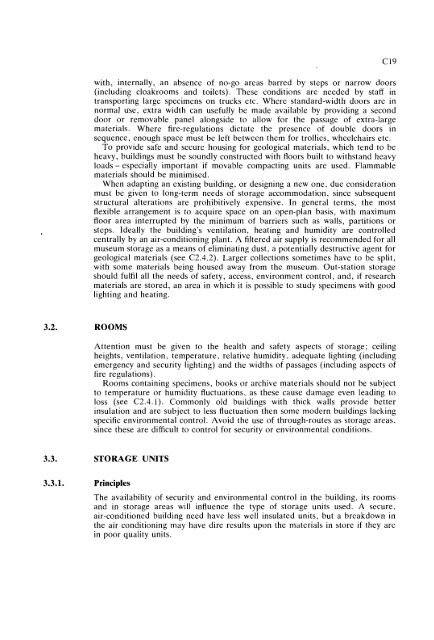GUIDELINES FOR THE CURATION OF GEOLOGICAL MATERIALS
GUIDELINES FOR THE CURATION OF GEOLOGICAL MATERIALS
GUIDELINES FOR THE CURATION OF GEOLOGICAL MATERIALS
Create successful ePaper yourself
Turn your PDF publications into a flip-book with our unique Google optimized e-Paper software.
with, internally, an absence of no-go areas barred by steps or narrow doors<br />
(including cloakrooms and toilets). These conditions are needed by staff in<br />
transporting large specimens on trucks etc. Where standard-width doors are in<br />
normal use, extra width can usefully be made available by providing a second<br />
door or removable panel alongside to allow for the passage of extra-large<br />
materials. Where fire-regulations dictate the presence of double doors in<br />
sequence, enough space must be left between them for trollies, wheelchairs etc.<br />
To provide safe and secure housing for geological materials, which tend to be<br />
heavy, buildings must be soundly constructed with floors built to withstand heavy<br />
loads - especially important if movable compacting units are used. Flammable<br />
materials should be minimised.<br />
When adapting an existing building, or designing a new one, due consideration<br />
must be given to long-term needs of storage accommodation, since subsequent<br />
structural alterations are prohibitively expensive. In general terms, the most<br />
flexible arrangement is to acquire space on an open-plan basis, with maximum<br />
floor area interrupted by the minimum of barriers such as walls, partitions or<br />
steps. Ideally the building's ventilation, heating and humidity are controlled<br />
centrally by an air-conditioning plant. A filtered air supply is recommended for all<br />
museum storage as a means of eliminating dust, a potentially destructive agent for<br />
geological materials (see C2.4.2). Larger collections sometimes have to be split,<br />
with some materials being housed away from the museum. Out-station storage<br />
should fulfil all the needs of safety, access, environment control, and, if research<br />
materials are stored, an area in which it is possible to study specimens with good<br />
lighting and heating.<br />
ROOMS<br />
Attention must be given to the health and safety aspects of storage; ceiling<br />
heights, ventilation, temperature, relative humidity. adequate lighting (including<br />
emergency and security lighting) and the widths of passages (including aspects of<br />
fire regulations).<br />
Rooms containing specimens, books or archive materials should not be subject<br />
to temperature or humidity fluctuations, as these cause damage even leading to<br />
loss (see C2.4.1). Commonly old buildings with thick walls provide better<br />
insulation and are subject to less fluctuation then some modern buildings lacking<br />
specific environmental control. Avoid the use of through-routes as storage areas,<br />
since these are difficult to control for security or environmental conditions.<br />
STORAGE UNITS<br />
3.3.1. Principles<br />
The availability of security and environmental control in the building, its rooms<br />
and in storage areas will influence the type of storage units used. A secure,<br />
air-conditioned building need have less well insulated units, but a breakdown in<br />
the air conditioning may have dire results upon the materials in store if they are<br />
in poor quality units.

















